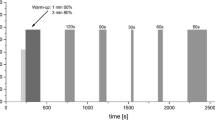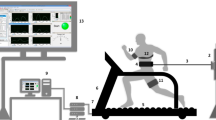Abstract
Purpose
The purpose of this study was to investigate the differences in resistance training adaptation on muscle oxygenation between young and elderly subjects. Groups of eleven trained young, untrained young, trained elderly, and untrained elderly (UTE) were recruited.
Methods
Muscle oxygenation of the vastus lateralis muscle during 20 % maximal voluntary isometric contraction was observed using near-infrared spectroscopy. The oxygen saturation (SpO2) kinetics in the contraction and recovery phases was modeled with a tangential model to extract ΔSpO2 and inflection time (IF). The median frequencies of SpO2 data representing the change of tissue oxygenation oscillation were compared.
Results
The ΔSpO2 values for the trained groups (12.00 ± 7.86 %) were significantly higher than those for the untrained groups (5.91 ± 4.36 %, P < 0.05), and those for the young groups (11.63 ± 7.52 %) were significantly higher than those for the older groups (6.29 ± 4.70 %, P < 0.05). In the recovery phase, the IF was significantly longer for the elderly groups (10.32 ± 4.39 s, P < 0.05) than that for the young groups (6.31 ± 3.69 s). The median frequency of tissue oxygenation oscillation was significantly lower for the TE group (0.41 ± 0.12 Hz, P < 0.05) than that for the UTE group (0.57 ± 0.13 Hz).
Conclusions
The increased ΔSpO2 in trained groups during muscle contraction may be due to lower microvascular O2 pressure. The lower median frequency for the TE group indicates that tissue oxygenation oscillation significantly trended toward low-frequency oscillation, possibly resulting from the enhancement of vascular function.




Similar content being viewed by others
Abbreviations
- FFT:
-
Fast Fourier transform
- IF:
-
Inflection time
- MVC:
-
Maximal voluntary contraction
- NIRS:
-
Near-infrared spectroscopy
- SD:
-
Standard deviation
- SpO2 :
-
Oxygen saturation
- TE:
-
Trained elderly
- TY:
-
Trained young
- UTE:
-
Untrained elderly
- UTY:
-
Untrained young
- VL:
-
Vastus lateralis
References
Behnke BJ, Delp MD, Dougherty PJ, Musch TI, Poole DC (2005) Effects of aging on microvascular oxygen pressures in rat skeletal muscle. Respir Physiol Neurobiol 146:259–268
Brandes RP, Fleming I, Busse R (2005) Endothelial aging. Cardiovasc Res 66:286–294
Cettolo V, Ferrari M, Biasini V, Quaresima V (2007) Vastus lateralis O2 desaturation in response to fast and short maximal contraction. Med Sci Sports Exerc 39:1949
Conley KE, Jubrias SA, Esselman PC (2000) Oxidative capacity and ageing in human muscle. J Physiol 526:203–210
Costes F, Denis C, Roche F, Prieur F, Enjolras F, Barthelemy J (1999) Age-associated alteration of muscle oxygenation measured by near infrared spectroscopy during exercise. Arch Physiol Biochem 107:159–167
Coza A, Nigg BM, Dunn JF (2011) Effects of vibrations on gastrocnemius medialis tissue oxygenation. Med Sci Sports Exerc 43:509–515
DeLorey DS, Kowalchuk JM, Paterson DH (2004) Effects of prior heavy-intensity exercise on pulmonary O2 uptake and muscle deoxygenation kinetics in young and older adult humans. J Appl Physiol 97:998–1005
DeLorey DS, Paterson DH, Kowalchuk JM (2007) Effects of ageing on muscle O2 utilization and muscle oxygenation during the transition to moderate-intensity exercise. Appl Physiol Nutr Metab 32:1251–1262
Delp MD (1995) Effects of exercise training on endothelium-dependent peripheral vascular responsiveness. Med Sci Sports Exerc 27:1152–1157
Faraci FM, Brian J (1994) Nitric oxide and the cerebral circulation. Stroke 25:692–703
Ferrari M, Mottola L, Quaresima V (2004) Principles, techniques, and limitations of near infrared spectroscopy. Can J Appl Physiol 29:463–487
Ferreira LF, McDonough P, Behnke BJ, Musch TI, Poole DC (2006) Blood flow and O2 extraction as a function of O2 uptake in muscles composed of different fiber types. Respir Physiol Neurobiol 153:237–249
Ferri A, Adamo S, Longaretti M, Marzorati M, Lanfranconi F, Marchi A, Grassi B (2007) Insights into central and peripheral factors affecting the “oxidative performance” of skeletal muscle in aging. Eur J Appl Physiol 100:571–579
Franceschini MA, Fantini S, Paunescu LA, Maier JS, Gratton E (1998) Influence of a superficial layer in the quantitative spectroscopic study of strongly scattering media. Appl Opt 37:7447–7458
Hamaoka T, Iwane H, Shimomitsu T, Katsumura T, Murase N, Nishio S, Osada T, Kurosawa Y, Chance B (1996) Noninvasive measures of oxidative metabolism on working human muscles by near-infrared spectroscopy. J Appl Physiol 81:1410–1417
Hirai DM, Copp SW, Ferguson SK, Holdsworth CT, McCullough DJ, Behnke BJ, Musch TI, Poole DC (2012) Exercise training and muscle microvascular oxygenation: functional role of nitric oxide. J Appl Physiol 113:557–565
Ichimura S, Murase N, Osada T, Kime R, Homma T, Ueda C, Nagasawa T, Motobe M, Hamaoka T, Katsumura T (2006) Age and activity status affect muscle reoxygenation time after maximal cycling exercise. Med Sci Sports Exerc 38:1277
Jensen BR, Krag I, Bronée L, Crenshaw A (2010) Tissue oxygenation and haemoglobin kinetics as a function of depth in two shoulder muscles differing in fibre-type composition. Int J Ind Ergonomics 40:135–139
Kirkendall DT, Garrett WE (1998) The effects of aging and training on skeletal muscle. Am J Sport Med 26:598–602
Larsson SE, Zhang Q, Larsson R, Cai H, Oberg PA (1996) Single-fibre laser Doppler flowmetry and electromyography for evaluating microcirculation in forearm muscle during static and continuous handgrip contractions. Eur J Appl Physiol Occup Physiol 73:219–224
Li Z, Zhang M, Chen G, Liu F, Li J (2012) Wavelet analysis of lumbar muscle oxygenation signals during whole-body vibration: implications for the development of localized muscle fatigue. Eur J Appl Physiol 112:3109–3117
Murias JM, Kowalchuk JM, Paterson DH (2010) Speeding of VO2 kinetics with endurance training in old and young men is associated with improved matching of local O2 delivery to muscle O2 utilization. J Appl Physiol 108:913–922
Muthalib M, Jubeau M, Millet GY, Maffiuletti NA, Nosaka K (2009) Comparison between electrically evoked and voluntary isometric contractions for biceps brachii muscle oxidative metabolism using near-infrared spectroscopy. Eur J Appl Physiol 107:235–241
Nader GA (2006) Concurrent strength and endurance training: from molecules to man. Med Sci Sports Exerc 38:1965
Nilsson H, Aalkjær C (2003) Vasomotion: mechanisms and physiological importance. Mol Interv 3:79
Nilwik R, Snijders T, Leenders M, Groen BB, van Kranenburg J, Verdijk LB, van Loon LJ (2013) The decline in skeletal muscle mass with aging is mainly attributed to a reduction in type II muscle fiber size. Exp Gerontol 48:492–498
Parker BA, Smithmyer SL, Ridout SJ, Ray CA, Proctor DN (2008) Age and microvascular responses to knee extensor exercise in women. Eur J Appl Physiol 103:343–351
Pereira MI, Gomes PS, Bhambhani YN (2007) A brief review of the use of near infrared spectroscopy with particular interest in resistance exercise. Sports Med 37:615–624
Rabischong E, Guiraud D (1993) Determination of fatigue in the electrically stimulated quadriceps muscle and relative effect of ischaemia. J Biomed Eng 15:443–445
Rakobowchuk M, McGowan C, De Groot P, Hartman J, Phillips S, MacDonald M (2005) Endothelial function of young healthy males following whole body resistance training. J Appl Physiol 98:2185–2190
Robertson P, Hart B (1999) Assessment of tissue oxygenation. Respir Care Clin N Am 5:221
Shiogai Y, Stefanovska A, McClintock PVE (2010) Nonlinear dynamics of cardiovascular ageing. Phys Rep 488:51–110
Tamaki T, Uchiyama S, Tamura T, Nakano S (1994) Changes in muscle oxygenation during weight-lifting exercise. Eur J Appl Physiol Occup Physiol 68:465–469
Uchiyama K, Miaki H, Terada S, Hoso M (2011) Effect of muscle strength training and muscle endurance training on muscle deoxygenation level and endurance performance. J Phys Ther Sci 23:349–355
Ušaj A, Jereb B, Robi P, von Duvillard SP (2007) The influence of strength-endurance training on the oxygenation of isometrically contracted forearm muscles. Eur J Appl Physiol 100:685–692
Acknowledgments
The authors would like to thank the Institute of Physical Education, Health and Leisure Studies, for assisting with subject recruitment. We would also like to thank the National Science Council of Taiwan for financially supporting this work under grants NSC 100-2410-H-006-077 and NSC 100-2321-B-006-018.
Conflict of interest
The authors have no conflicts of interest to disclose.
Author information
Authors and Affiliations
Corresponding author
Additional information
Communicated by Michael Lindinger.
Rights and permissions
About this article
Cite this article
Lin, TY., Lin, L.L., Ho, TC. et al. Investigating the adaptation of muscle oxygenation to resistance training for elders and young men using near-infrared spectroscopy. Eur J Appl Physiol 114, 187–196 (2014). https://doi.org/10.1007/s00421-013-2763-z
Received:
Accepted:
Published:
Issue Date:
DOI: https://doi.org/10.1007/s00421-013-2763-z




